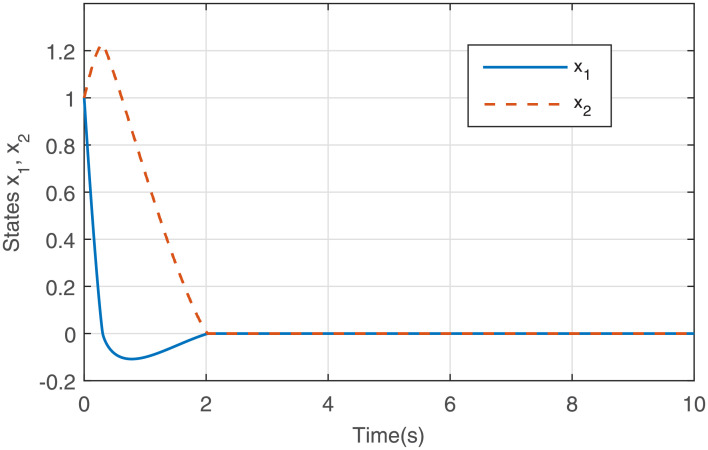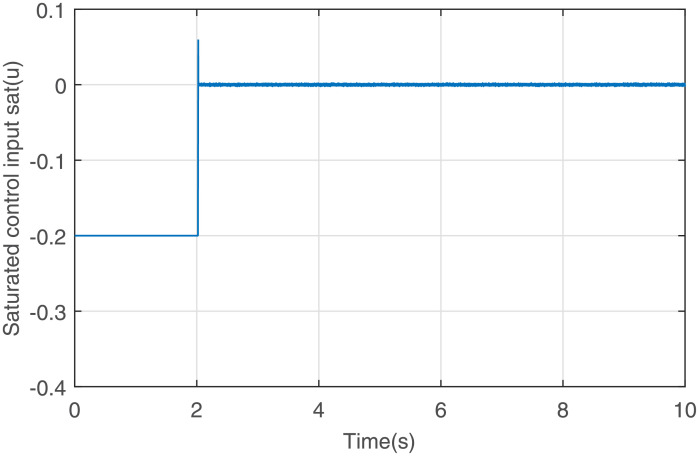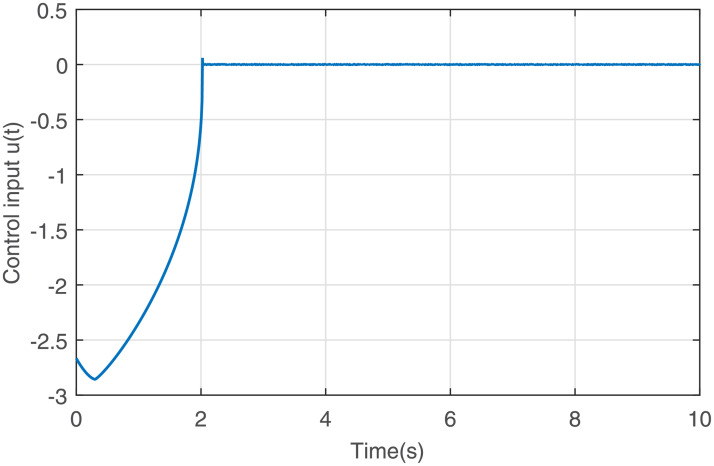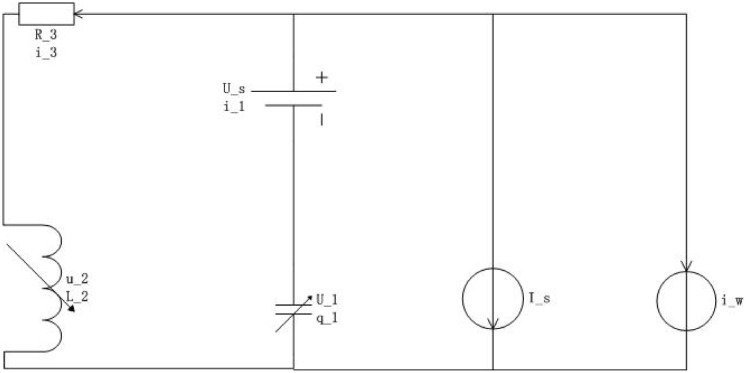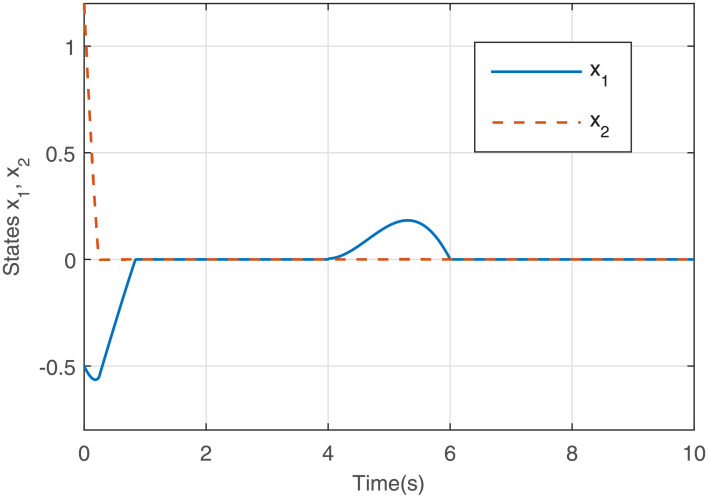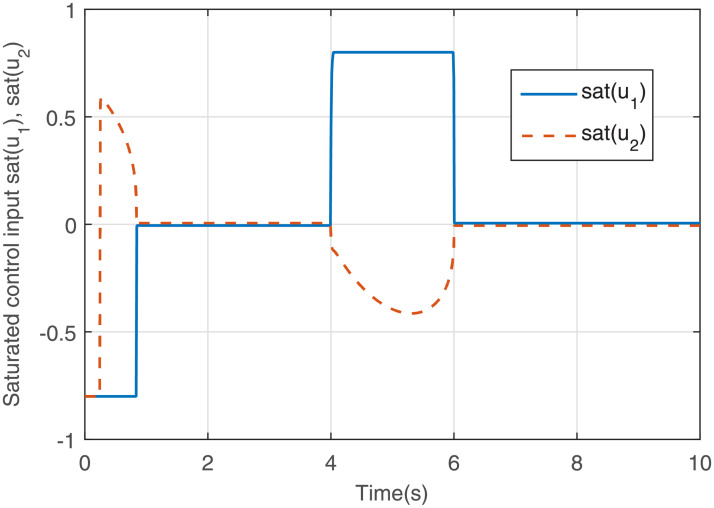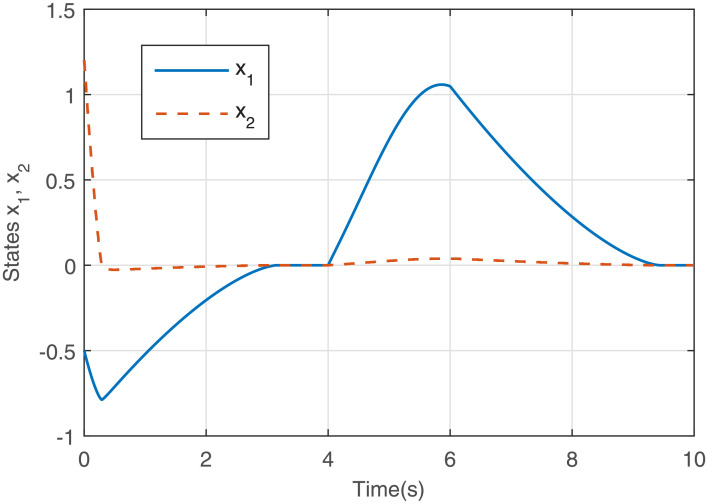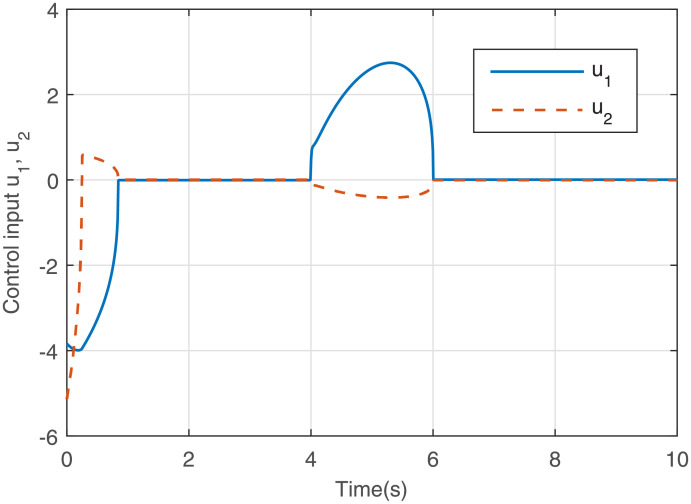Abstract
The finite-time stabilization and finite-time H∞ control problems of Port-controlled Hamiltonian (PCH) systems with disturbances and input saturation (IS) are studied in this paper. First, by designing an appropriate output feedback, a strictly dissipative PCH system is obtained and finite-time stabilization result for nominal system is given. Second, with the help of the Hamilton function method and truncation inequality technique, a novel output feedback controller is developed to make the PCH system finite-time stable when IS occurs. Further, a finite-time H∞ controller is designed to attenuate disturbances for PCH systems with IS, and sufficient conditions are presented. Finally, a numerical example and a circuit example are given to reveal the feasibility of the obtained theoretical results.
Introduction
The Port-controlled Hamiltonian (PCH) system has been studied well [1–4] since it was put forward [5, 6]. In practical systems, the Hamilton function [7–9], as the total energy containing kinetic energy and potential energy, is a good candidate of Lyapunov function. Apart from the significant Hamilton function, the PCH system’s other structures also have important physical meaning. Thus, many practical systems can be expressed as PCH systems and the PCH system has received wide attention in nonlinear analysis and synthesis [10–13]. Up to now, lots of results on stability analysis and control designs for PCH systems have been presented based on Hamilton function method [14–18].
Under asymptotically stabilized controller, system states can only converge to desired equilibrium points in infinite time, which is a common result. In order to optimize control time, the concept of finite-time stability naturally arises and further finite-time stability theory is developed to improve control performance. In fact, the finite-time control approach has the following significant superiorities: the closed-loop system possesses faster convergence speed and better robustness against uncertainties and disturbances [19–22]. Because of these advantages, finite-time control problems have received a great deal of attention and lots of results have been given in a series of literatures [23–26]. For a class of systems with mismatched disturbances [27], studies the finite-time output regulation problem utilizing the finite-time disturbance observer technique. For a class of nonlinear systems, the finite-time stabilization problem is investigated by constructing a suitable sliding mode control law [29]. For a class of discrete time-delay switched systems, with the help of the average dwell time approach [29]solves the finite-time H∞ control problem. For a class of Hamiltonian descriptor systems, the finite-time stabilization problem as well as the H∞ control problem is studied utilizing the Hamilton function method in [30].
Practical systems are often constrained by the limited capacity of physical components. Among these constraint phenomena [31–34], input saturation (IS) is a very common one, which usually destroys the control performance of systems and even results in instability. Since 1950s, control problems of systems with IS has attracted considerable attention and plenty of studies have been reported [35–38]. For uncertain nonstrict-feedback nonlinear systems with IS, the finite-time tracking control problem is addressed via dynamic surface control technique and backstepping approach in [35]. [36] studies finite-time feedback control for input-delay system with nonlinear IS using the comparison function method. Adaptive neural network control for full-state constrained robotic manipulator with IS and time-varying delays is studied in [37]. Utilizing Lyapunov-Krasovskii functional theorem and linear matrix inequalities [38], investigates stabilization problem of time-delay Hamiltonian systems subject to IS. Although lots of results have been presented about stabilization and finite-time stabilization of nonlinear systems in the presence of IS, to our best knowledge, there are fewer results on the finite-time control design of PCH systems with disturbances and IS.
The finite-time stabilization and finite-time H∞ control problems for PCH systems with disturbances and IS are concerned in this paper. First, the nominal PCH system (without disturbances and IS) is investigated. By utilizing the system’s structural properties and the output feedback strategy, the strictly dissipative PCH system and finite-time stability condition are obtained. Second, the finite-time stabilization problem for the case with IS is studied by designing an output feedback controller using the truncation inequality technique and Hamilton function method. Third, the finite-time H∞ control problem for the case with IS is addressed, and the sufficient condition is proposed. Finally, a numerical example and a circuit example are given to verify the obtained results.
The contribution is that the strictly dissipative PCH system and finite-time stability condition obtained in this paper, have provided a novel approach to the finite-time stability analysis of PCH systems. Section 3 demonstrates the application of this approach, which discusses the finite-time stabilization and finite-time H∞ control problems of disturbed PCH systems with IS. We call this novel approach Hamilton function-based analysis method, which includes two cases. (i) The Hamiltonian system is expressed as the strictly dissipative PCH system by designing an appropriate output feedback controller, and the obtained PCH system is finite-time stable. (ii) Under some constraint conditions, the strictly dissipative PCH system cannot be obtained. However, by utilizing the idea of constructing strictly dissipative PCH systems, the positive definite damping matrix can be obtained in the proof, which is very helpful to analyze the finite-time stability of the closed-loop system. It is the advantage that this method applies the systems’ structural properties to controller design and stability analysis effectively. However, different constraints may lead to the theoretical method obtained not being able to solve all related problems. Fortunately, there is at least one broad category where solutions can be found under the theories. We believe that under the PCH systems’ framework, most control problems with saturation can be solved with the development of control theory.
The rest of this article is given below. The problem statement and preliminaries are presented in Section 2. Section 3 addresses the finite-time stabilization problem of the case without and with IS, and the H∞ control problem of the case with IS and disturbances. Two examples with simulations are presented in Section 4. Section 5 gives the conclusion in final.
Notation: The transposition of matrix g(ζ) is denoted by gT(ζ). The positive definite matrix R(ζ) is denoted by R(ζ)>0. The positive semi-definite matrix R(ζ) is denoted by R(ζ)≥0. |a| stands for the absolute value of real number a. ‖R‖ represents the Euclidean norm of R. ∇E(ζ) denotes .
Problem statement and preliminaries
A PCH system subject to disturbances and IS is considered
| (1) |
where is the state, is the control input, is the output, is the disturbance in L2, and is the penalty signal. The Hamilton function E(ζ) has a minimum point at ζ = 0, and ∇E(ζ) is the gradient of E(ζ). is the interconnection matrix, is the damping matrix, M(ζ) is the weighting matrix, is the full column rank gain matrix, (R, g1) is a full row rank matrix, , and is the IS function with
| (2) |
pi is a positive real number which represents the upper bound of the saturated function sat(Ui).
For the subsequent analysis, the following four lemmas are adopted.
Lemma 1 ([39]) Jensen’s inequality:
| (3) |
where r1, r2 and aj are real numbers.
Let and r2 = 1 in Lemma 1, then the following inequality is derived
| (4) |
Lemma 2 ([19]) The following system is considered
| (5) |
If there is a C1radially unbounded Lyapunov function V(ψ) and a real number b > 1 making inequality (6) holds along system (5) with any ,
| (6) |
then system (5) is globally finite-time stable.
Lemma 3 ([32, 40]) Truncation-inequality technique: Consider the saturation function sat(U) defined in (2). Then, the inequality holds
| (7) |
where δ = sat(U) − U, 0 < ϵ ≤ 1.
Lemma 4 ([41]) The following system is given
| (8) |
where ψ is the state, z is the penalty signal and D is the disturbance.
If there is a function V(ψ) satisfying the following Hamiltonian-Jacobian inequality,
| (9) |
then the L2gain from D to z is no bigger thanγ, i.e.,
| (10) |
where V(ψ) > 0 with ψ ≠ 0, V(0) = 0, and γ > 0.
Assumption 1The Hamilton function E(ζ) satisfies the condition, where η > 1 is a real number.
Remark 1As the total energy function of PCH systems, the Hamilton function E(ζ) is usually selected as the form in Assumption 1, and it represents a very important class of Hamilton functions in mechanical systems.
In order to deal with the finite-time control problems of PCH system (1) with disturbances and IS, several novel control schemes are presented via output feedback strategies and truncation-inequality technique.
Main results
In this part, the finite-time control problems of PCH system (1) subject to disturbances and IS are considered. For nominal PCH system, the finite-time stabilization result is given first. Next, the finite-time stabilization result of PCH system is also proposed when IS occurs. Finally, the finite-time H∞ control problem for the case with disturbances and IS is studied.
Finite-time stabilization for nominal PCH systems
PCH system (1) with d(t) = 0 and sat(U) = U is considered in this subsection, i.e., the nominal system (11) is obtained
| (11) |
For matrix R(ζ) of system (11), two cases on positive semi-definite and positive definite are first discussed.
Case 1: If R(ζ) is a positive definite matrix, then system (11) is a strictly dissipative PCH system.
- Case 2: If R(ζ) is a positive semi-definite matrix, an appropriate output feedback controller
is needed designing to make new matrix positive definite. Then, system (11) can be transformed into the following strictly dissipative PCH system,(12)
where K is a symmetric matrix with proper dimensions,(13) (14)
According to the above discussion, a result is given.
Theorem 1Consider nominal PCH system (11) with Assumption 1. Suppose the condition (14) holds, then the output feedback controller (12) can finite-time stabilize PCH system (11).
Proof. Substituting output feedback controller (12) into system (11), the strictly dissipative PCH system (13) is derived. Taking E(ζ) as the Lyapunov function and calculating its derivative along system (11), one obtains
| (15) |
where
| (16) |
are the eigenvalues of matrix , i = 1, 2, …, n.
From Lemma 1, it yields
| (17) |
i.e.,
| (18) |
From Lemma 2, one gets that the closed-loop PCH system (11) with output feedback controller (12) is globally finite-time stable.
Remark 2If matrix R(ζ) is positive definite, i.e., case 1 is considered, PCH system (11) is a strictly dissipative PCH system with U = 0. In output feedback controller (12), we just choose K = 0, and the PCH system (11) is also globally finite-time stable.
Finite-time stabilization for PCH systems with IS
PCH system (1) with d(t) = 0 is considered in this subsection, i.e.,
| (19) |
Via the Hamilton function method and truncation-inequality method, a novel output feedback strategy is developed to solve the finite-time stabilization problem of system (19). Now, the relevant theorem is given as follows.
Theorem 2Consider PCH system (19) with Assumption 1. If there exists a matrix K with KT = K and proper dimensions satisfying the following condition,
| (20) |
then the output feedback controller
| (21) |
can finite-time stabilize PCH system (19) globally.
Proof. Define δ = sat(U) − U, then system (19) can be rewritten as
| (22) |
Choosing Hamilton function E(ζ) as the Lyapunov function and calculating its derivative, we have
| (23) |
Utilizing truncation-inequality technique in Lemma 3, it yields
| (24) |
where
| (25) |
are the eigenvalues of matrix , i = 1, 2, …, n.
According to Lemma 1, one obtains
| (26) |
According to the above analysis and Lemma 2, it can be concluded output feedback controller (21) can finite-time stabilize PCH system (20).
Remark 3Under IS constraints, the strictly dissipative PCH system is not obtained and hence the finite-time stabilization result cannot be yielded directly. However, the positive definite damping matrix is obtained utilizing the idea of constructing strictly dissipative PCH systems and truncation-inequality technique, which helps to prove the finite-time stability of the closed-loop system in Theorem 2.
Finite-time H∞ control for PCH systems with IS
In this subsection, PCH system (1) with d(t)≠0 is considered. To investigate the finite-time H∞ control problem, a novel output feedback controller is designed using Hamiltonian-Jacobian inequality technique and truncation-inequality method. And the result is derived as follows.
Theorem 3Consider PCH system (1) with Assumption 1. Suppose there exists a symmetric matrix K with proper dimensions and a number γ > 0 satisfying the following conditions,
| (27) |
| (28) |
then the output feedback controller
| (29) |
can effectively solve the finite-time H∞ control problem of PCH system (1).
Proof. Set δ = sat(U) − U. Substituting output feedback control law (29) into system (1), the following closed-loop system is obtained
| (30) |
The proof is divided into two parts. Part 1, system (30) has a finite-time L2 gain. Part 2, when d(t) = 0, system (30) is finite-time stable.
We will prove part 1 first. Choose the Lyapunov function E(ζ), and define
| (31) |
According to truncation-inequality and Young’s inequality, one has
| (32) |
Based on (32), it follows from condition (28) that
| (33) |
According to the Hamiltonian-Jacobian inequality in Lemma 4, one gets the L2 gain of system (30) is not bigger than γ.
Next, part 2 will be proved. Calculating the derivative of E(ζ) when d(t) = 0, one obtains the following result,
| (34) |
Condition (27) implies matrix .
Let
| (35) |
where are the eigenvalues of matrix , i = 1, 2, …, n.
Thus, inequality (34) can be written as
| (36) |
From Lemma 1, it is further deduced that
| (37) |
According to Lemma 2, one gets that when d(t) = 0, the closed-loop system (30) is globally finite-time stable.
Therefore, the finite-time H∞ control problem of PCH system (1) is solved.
Remark 4In this paper, the salient features are reflected in the following several aspects compared with the existing research results [30, 31, 35–38]. (i) Compared with the inequality technique in [31, 36], the truncation inequality technique, borrowed to address IS, is more feasible. (ii) Different from the the result that the state is bounded in finite-time [35], our aim is that the state converges to the equilibrium point in finite-time. (iii) Via the Hamilton function method and finite-time control technique, two novel output feedback control laws are designed to solve the finite-time stabilization and finite-time H∞ control problems of PCH systems in the presence of disturbances and IS, which is different from the stabilization of Hamiltonian systems without disturbances and with IS [38] and the finite-time H∞ control for Hamiltonian descriptor systems without IS [30].
Simulations
This section presents two simulation examples to reveal the feasibility of the proposed control methods.
Example 1. The following PCH system with IS is considered
| (38) |
where the state , the Hamilton function , , , , is the saturated control input and given as
| (39) |
By choosing K = 2 and , we know the condition (20) holds, where
| (40) |
and all the conditions hold in Theorem 2.
Based on Eq (21), the output feedback law is designed as
| (41) |
According to Theorem 2, it is easy to get that control law (41) can finite-time stabilize system (38).
To demonstrate the feasibility of the control strategy, the initial condition x1(0) = 1 = x2(0) is first given and further the simulation is carried out.
Figs 1 to 3 present the simulation results. Fig 1 illustrates that the states x1 and x2 converge to the equilibrium point fast via the output feedback control (41) when IS is considered, i.e., closed-loop system (38) is finite-time stable. The response curve of the output feedback signal is given in Fig 2. Fig 3 is the response curve of the saturated control input sat(u), and the amplitudes of the response curve are all within the saturation range. The simulations reveal that the output feedback control strategy with IS is effective.
Fig 1. States x1 and x2 with sat(u).
Fig 3. Response curve of the saturated control input sat(u).
Fig 2. Response curve of the output feedback signal.
Example 2.Fig 4 ([18]) describes the nonlinear circuit system, where the magnetic flux ψ controls the inductance, the electric charge q controls the capacitance, i3 = f1(ψ) is current, U1 = f2(q) is voltage, and the current source disturbance is denoted by iw.
Fig 4. Nonlinear circuit system.
The system is written as follows by Kirchhoff’s Law,
| (42) |
Denote , and R3 = 3. Let the state x = (x1, x2)T = (q, ψ)T, the control input u = (u1, u2)T = (Is, Us)T, and the disturbance d(t) = iw. Then system (42) is expressed as the PCH system
| (43) |
where , and .
Considering IS, system (43) with disturbances is rewritten as
| (44) |
where y, d(t) and z are the output, the disturbance and the penalty signal, respectively. is the saturated control input and given as
| (45) |
For disturbance attenuation level γ = 1, we choose symmetric matrix , the weighting matrix and . Through verification, we find that these conditions in Theorem 3 hold, where
| (46) |
| (47) |
| (48) |
According to Eq (29), the output feedback law is obtained
| (49) |
From Theorem 3, we know that controller (49) can effectively solve the problem of finite-time H∞ control of PCH system (44).
The simulation is carried out with initial condition x1(0) = −0.5 and x2(0) = 1.2. To verify the robustness of the proposed controller against disturbances, the current source disturbance d(t) = iw = 1.1sin t is added into system (44) when 4s ≤ t ≤ 6s.
Figs 5 to 8 give the simulation results. The response curves of states x1 and x2 with and without the saturated control input are shown in Figs 5 and 6, respectively. It can be seen that compared with Fig 6, the effect of the disturbance on the system is well suppressed when the disturbance appears in Fig 5. After the disturbance vanishes, the states converge to the equilibrium point faster in Fig 5. The response curves of the output feedback control are given in Fig 7. Fig 8 shows the response curves of the saturated control input sat(u), and the amplitudes of the response curves are all within the saturation range. The simulations illustrate that the output feedback controller is very effective against disturbances subject to IS. Therefore, when IS is considered, the proposed finite-time H∞ control strategy is valid.
Fig 5. States x1 and x2 with disturbance and sat(u).
Fig 8. Response curves of the saturated control input sat(u).
Fig 6. States x1 and x2 with disturbance and without sat(u).
Fig 7. Response curves of the output feedback signal.
Conclusion
The problems of finite-time stabilization and finite-time H∞ control of PCH systems subject to disturbances and IS have been studied in this paper. By using system’s structure characteristics and an appropriate output feedback, the strictly dissipative PCH system has been obtained first. Second, the finite-time stabilization results for the case without and with IS have been presented using the Hamilton function method and truncation inequality technique. Next, the finite-time H∞ control problem for PCH system with disturbances and IS has also been solved. Finally, two examples have been proposed to illustrative the effectiveness of the theoretical results.
The control method proposed has been applied to two simulation examples in this paper. In fact, compared with the simulation results, the experimental results can better illustrate the effectiveness of the proposed method. It is of great theoretical and engineering significance to investigate engineering systems’ experiments using the proposed control scheme, which will be studied in the future.
Supporting information
(ZIP)
Data Availability
All relevant data are within the manuscript and its Supporting information files.
Funding Statement
This work is supported by the National Natural Science Foundation of China under Grants 61903212 (received by Qingzhi Wang) and 61903232 (received by Ping Li)and the Natural Science Foundation of Shandong Province under Grant ZR2019BF044 (received by Qingzhi Wang).
References
- 1.Cheng DZ, Spurgeon S. Stabilization of Hamiltonian systems with dissipation. Int J Control. 2001Mar;74(5):465–473. doi: 10.1080/00207170010010551 [DOI] [Google Scholar]
- 2.Cheng DZ, Astolfi A, Ortega R. On feedback equivalence to port-controlled Hamiltonian systems. Syst Contr Lett. 2005Sep;54(9):911–917. doi: 10.1016/j.sysconle.2005.02.005 [DOI] [Google Scholar]
- 3.Sun WW, Lv XY, Qiu MY. Distributed estimation for stochastic Hamiltonian systems with fading wireless channels. IEEE Trans Cybern. 2020Oct. doi: 10.1109/TCYB.2020.3023547 [DOI] [PubMed] [Google Scholar]
- 4.Liu XG, Liao XF. Fixed-time stabilization control for port-Hamiltonian systems. Nonlinear Dyn. 2019Apr;96(2):1497–1509. doi: 10.1007/s11071-019-04867-0 [DOI] [Google Scholar]
- 5.Maschke BM, van der Schaft AJ. Port-controlled Hamiltonian systems: modelling origins and systemtheoretic properties. Proc the IFAC symposium Nonlin Control Syst Design. Bordeaux, France, 1992 Jun;282–288.
- 6.van der Schaft AJ, Maschke BM. The Hamiltonian formulation of energy conserving physical systems with external ports. Archive fur Elektronik und ubertragungstechnik. 1995Sep-Nov;49(5–6):362–371. [Google Scholar]
- 7.Yu HS, Yu JP, Liu J, Song Q. Nonlinear control of induction motors based on state error PCH and energy-shaping principle. Nonlinear Dynam. 2013Apr;72(1–2):49–59. doi: 10.1007/s11071-012-0689-3 [DOI] [Google Scholar]
- 8.Fu BZ, Li SH, Guo L, Yang J, Lan QX. Finite-time stabilization of port-controlled Hamiltonian systems with nonvanishing disturbances. Trans Inst Meas Control. 2018Jun;40(10):2973–2981. doi: 10.1177/0142331217712381 [DOI] [Google Scholar]
- 9.Sun WW, Wu Y, Wang LP. Trajectory tracking of constrained robotic systems via a hybrid control strategy. Neurocomputing. 2019Feb;330:188–195. doi: 10.1016/j.neucom.2018.11.008 [DOI] [Google Scholar]
- 10.Sun WW, Fu BZ. Adaptive control of time-varying uncertain non-linear systems with input delay: a Hamiltonian approach. IET Control Theory Appl. 2016Oct;10(15):1844–1858. doi: 10.1049/iet-cta.2015.1165 [DOI] [Google Scholar]
- 11.Cao Z, Hou XR, Zhao WJ. A family of robust simultaneous controllers with tuning parameters design for a set of port-controlled Hamiltonian systems. Asian J Control. 2017Jan;19(1):151–163. doi: 10.1002/asjc.1341 [DOI] [Google Scholar]
- 12.Fu BZ, Li SH, Yang J, Guo L. Global output regulation for a class of single input Port-controlled Hamiltonian disturbed systems. Appl Math Comput. 2018May;325:322–331. [Google Scholar]
- 13.Xu T, Yu HS, Yu JP, Meng XX. Adaptive disturbance attenuation control of two tank liquid level system with uncertain parameters based on Port-Controlled Hamiltonian. IEEE Access. 2020Mar;8:47384–47392. doi: 10.1109/ACCESS.2020.2979352 [DOI] [Google Scholar]
- 14.Liu XG, Liao XF. Fixed-time H∞ control for port-controlled Hamiltonian systems. IEEE Trans Autom Control. 2019Jul;64(7):2753–2765. doi: 10.1109/TAC.2018.2874768 [DOI] [Google Scholar]
- 15.Fu BZ, Li SH, Wang XY, Guo L. Output feedback based simultaneous stabilization of two Port-controlled Hamiltonian systems with disturbances. J Frankl Inst-Eng Appl Math. 2019Oct;356(15):8154–8166. doi: 10.1016/j.jfranklin.2019.02.039 [DOI] [Google Scholar]
- 16.Fu BZ, Wang QZ, He W. Nonlinear disturbance observer-based control for a class of port-controlled Hamiltonian disturbed systems. IEEE Access. 2018Sep;6:50299–50305. doi: 10.1109/ACCESS.2018.2868919 [DOI] [Google Scholar]
- 17.Ortega R, Spong MW, Gomez-Estern F, Blankenstein G. Stabilization of underactuated mechanical systems via interconnection and damping assignment. IEEE Trans Autom Control. 2002Aug;47(8):1218–1233. doi: 10.1109/TAC.2002.800770 [DOI] [Google Scholar]
- 18.Ren Y, Sun WW. Robust adaptive control for robotic systems with input time-varying delay using Hamiltonian method. IEEE/CAA J Autom Sinica. 2018Jul;5(4):852–859. doi: 10.1109/JAS.2016.7510055 [DOI] [Google Scholar]
- 19.Bhat SP, Bernstein DS. Continuous finite-time stabilization of the translational and rotational double integrators. IEEE Trans Autom Control. 1998May;43(5):678–682. doi: 10.1109/9.668834 [DOI] [Google Scholar]
- 20.Wang YZ, Feng G. Finite-time stabilization of Port-controlled Hamiltonian systems with application to nonlinear affine systems. Proc Amer Control Conf. 2008Jun;1202–1207. [Google Scholar]
- 21.Lan QX, Li SH, Yang J. Finite-time tracking control for a class of nonlinear systems with multiple mismatched disturbances. Int J Robust Nonlinear Control. 2020Jul;30(10):4095–4111. doi: 10.1002/rnc.4989 [DOI] [Google Scholar]
- 22.Li SH, Tian Y-P. Finite-time stability of cascaded time-varying systems. Int J Control. 2007Apr;80(4):646–657. doi: 10.1080/00207170601148291 [DOI] [Google Scholar]
- 23.Wang XY, Wang GD, Li SH. Distributed finite-time optimization for integrator chain multiagent systems with disturbances. IEEE Trans Autom Control. 2020Dec;65(12):5296–5311. doi: 10.1109/TAC.2020.2979274 [DOI] [Google Scholar]
- 24.Du HB, He YG, Cheng YY. Finite-time synchronization of a class of second-order nonlinear multi-agent systems using output feedback control. IEEE Trans Circuits Syst I-Regul Pap. 2014Jun;61(6):1778–1788. doi: 10.1109/TCSI.2013.2295012 [DOI] [Google Scholar]
- 25.Zhu WW, Du HB, Li SH, Yu XH. Design of output-based finite-time convergent composite controller for a class of perturbed second-order nonlinear systems. IEEE Trans Syst Man Cybern-Syst. 2020Jan. doi: 10.1109/TSMC.2020.2965654 [DOI] [Google Scholar]
- 26.Li XD, Yang XY, Song SJ. Lyapunov conditions for finite-time stability of time-varying time-delay systems. Automatica. 2019May;103:135–140. doi: 10.1016/j.automatica.2019.01.031 [DOI] [Google Scholar]
- 27.Li SH, Sun HB, Yang J, Yu XH. Continuous finite-time output regulation for disturbed systems under mismatching condition. IEEE Trans Autom Control. 2014May;60(1):277–282. doi: 10.1109/TAC.2016.2553128 [DOI] [Google Scholar]
- 28.Song J, Niu YG, Zou YY. Finite-time stabilization via sliding mode control. IEEE Trans Autom Control. 2016Jun;62(3):1478–1483. doi: 10.1109/TAC.2016.2578300 [DOI] [Google Scholar]
- 29.Zong GD, Wang RH, Zheng WX, Hou LL. Finite-time H∞ control for discrete-time switched nonlinear systems with time delay. Int J Robust Nonlinear Control. 2015Apr;25(6):914–936. doi: 10.1002/rnc.3121 [DOI] [Google Scholar]
- 30.Sun LY, Feng G, Wang YZ. Finite-time stabilization and H∞ control for a class of nonlinear Hamiltonian descriptor systems with application to affine nonlinear descriptor systems. Automatica. 2014Aug;50(8):2090–2097. [Google Scholar]
- 31.Lin XZ, Li XL, Zou Y, Li SH. Finite-time stabilization of switched linear systems with nonlinear saturating actuators. J Frankl Inst-Eng Appl Math. 2014Mar;351(3):1464–1482. doi: 10.1016/j.jfranklin.2013.11.013 [DOI] [Google Scholar]
- 32.Wei AR, Wang YZ. Stabilization and H∞ control of nonlinear port-controlled hamiltonian systems subject to actuator saturation. Automatica. 2010Dec;46(12):2008–2013. doi: 10.1016/j.automatica.2010.08.001 [DOI] [Google Scholar]
- 33.Ren Y, Zhao ZJ, Zhang CL, Yang QM, Hong K-S. Adaptive neural network boundary control for a flexible manipulator with input constraints and model uncertainties. IEEE Trans Cybern. 2020Oct. doi: 10.1109/TCYB.2020.3021069 [DOI] [PubMed] [Google Scholar]
- 34.Ren Y, Zhu PC, Zhao ZJ, Yang JF, Zou T. Adaptive fault-tolerant boundary control for a flexible string with unknown dead-zone and actuator fault. IEEE Trans Cybern. 2021Jan. doi: 10.1109/TCYB.2020.3044144 [DOI] [PubMed] [Google Scholar]
- 35.Ma L, Zong GD, Zhao XD, Huo X. Observer-based adaptive finite-time tracking control for a class of nonstrict-feedback nonlinear systems with input saturation. J Frankl Inst-Eng Appl Math. 2020Nov;357(16):11518–11544. doi: 10.1016/j.jfranklin.2019.07.021 [DOI] [Google Scholar]
- 36.Lin XZ, Huang ST, Li SH, Zou Y. Finite-time feedback control of an input-delay system with nonlinear saturating actuators. Trans Inst Meas Control. 2018Jun;40(10):3059–3067. doi: 10.1177/0142331217713836 [DOI] [Google Scholar]
- 37.Sun WW, Wu Y, Lv XY. Adaptive neural network control for full-state constrained robotic manipulator with actuator saturation and time-varying delays. IEEE Trans Neural Netw Learn Syst. 2021Jan. doi: 10.1109/TNNLS.2021.3051946 [DOI] [PubMed] [Google Scholar]
- 38.Sun WW. Stabilization analysis of time-delay Hamiltonian systems in the presence of saturation. Appl Math Comput. 2011Aug;217(23):9625–9634. [Google Scholar]
- 39.Hong YG, Jiang ZP. Finite-time stabilization of nonlinear systems with parametric and dynamic uncertainties. IEEE Trans Autom Control. 2006Dec;51(12):1950–1956. doi: 10.1109/TAC.2006.886515 [DOI] [Google Scholar]
- 40.Wang ZM, Wei AR, Zhang XF. Stability analysis and control design based on average dwell time approaches for switched nonlinear port-controlled hamiltonian systems. J Frankl Inst-Eng Appl Math. 2019Apr;356(6):3368–3397. doi: 10.1016/j.jfranklin.2019.02.024 [DOI] [Google Scholar]
- 41.Shen TL. H∞ control theory and its applications. Beijing, China: Tsinghua University Press.; 1996. [Google Scholar]
Associated Data
This section collects any data citations, data availability statements, or supplementary materials included in this article.
Supplementary Materials
(ZIP)
Data Availability Statement
All relevant data are within the manuscript and its Supporting information files.



